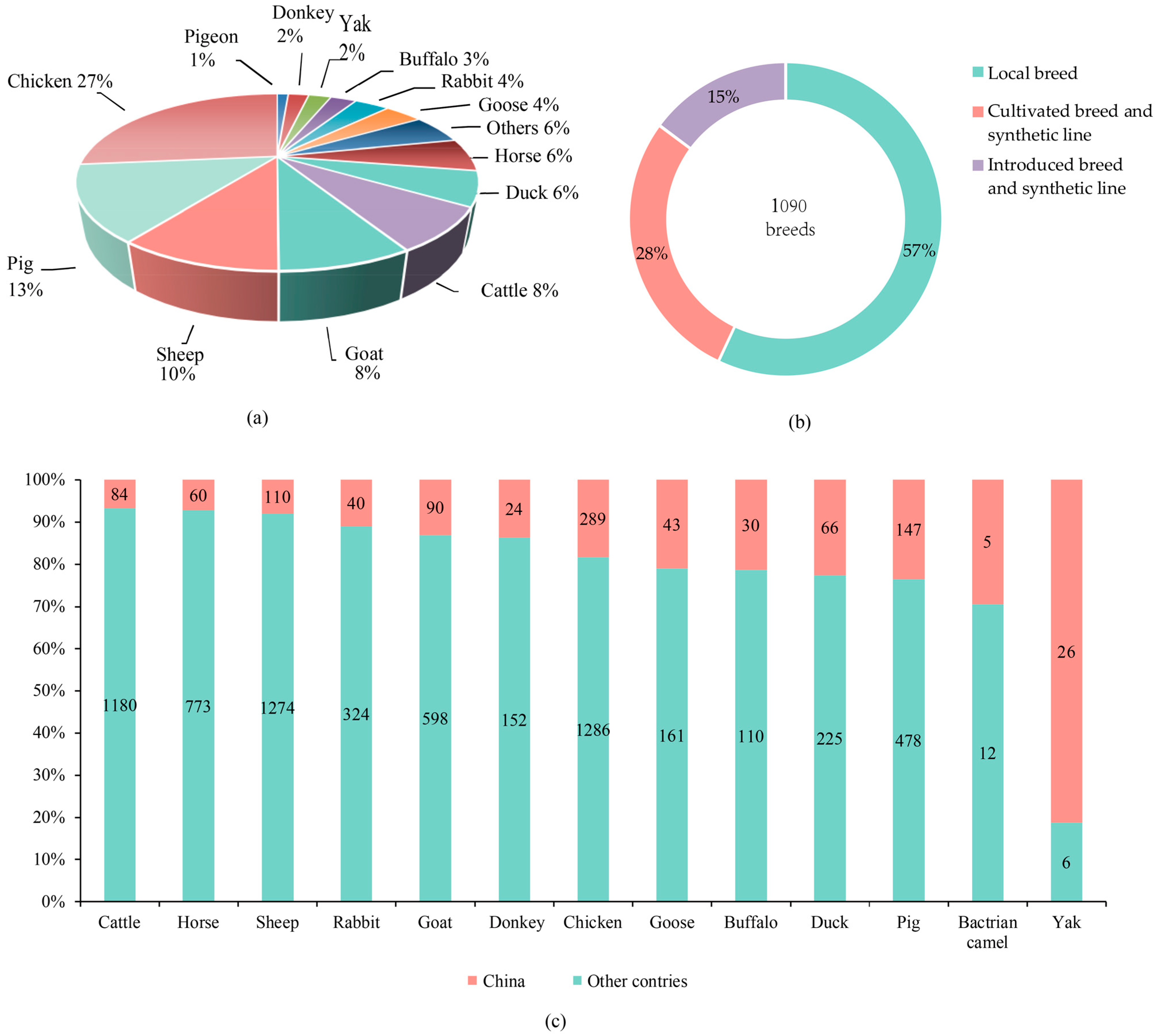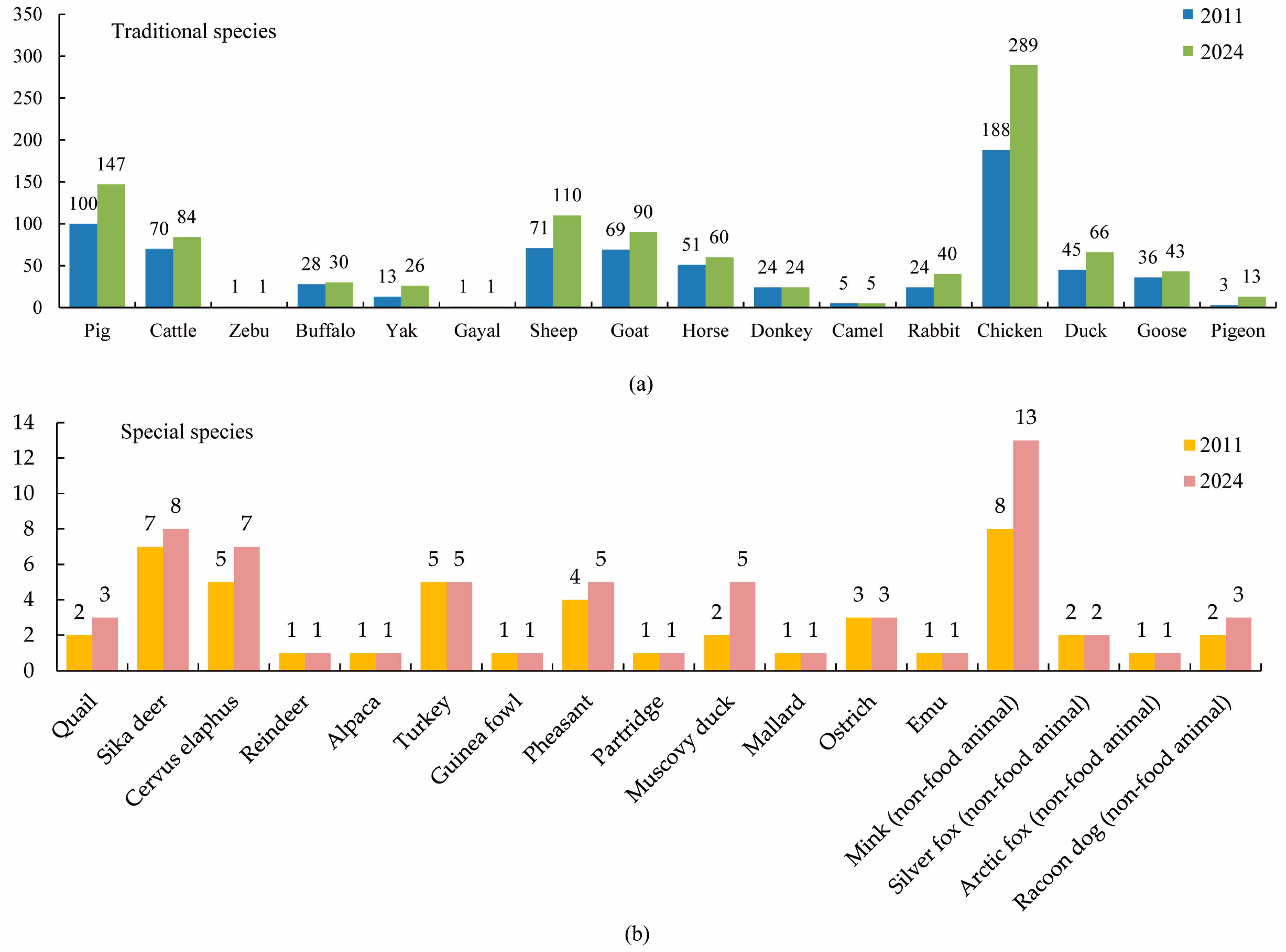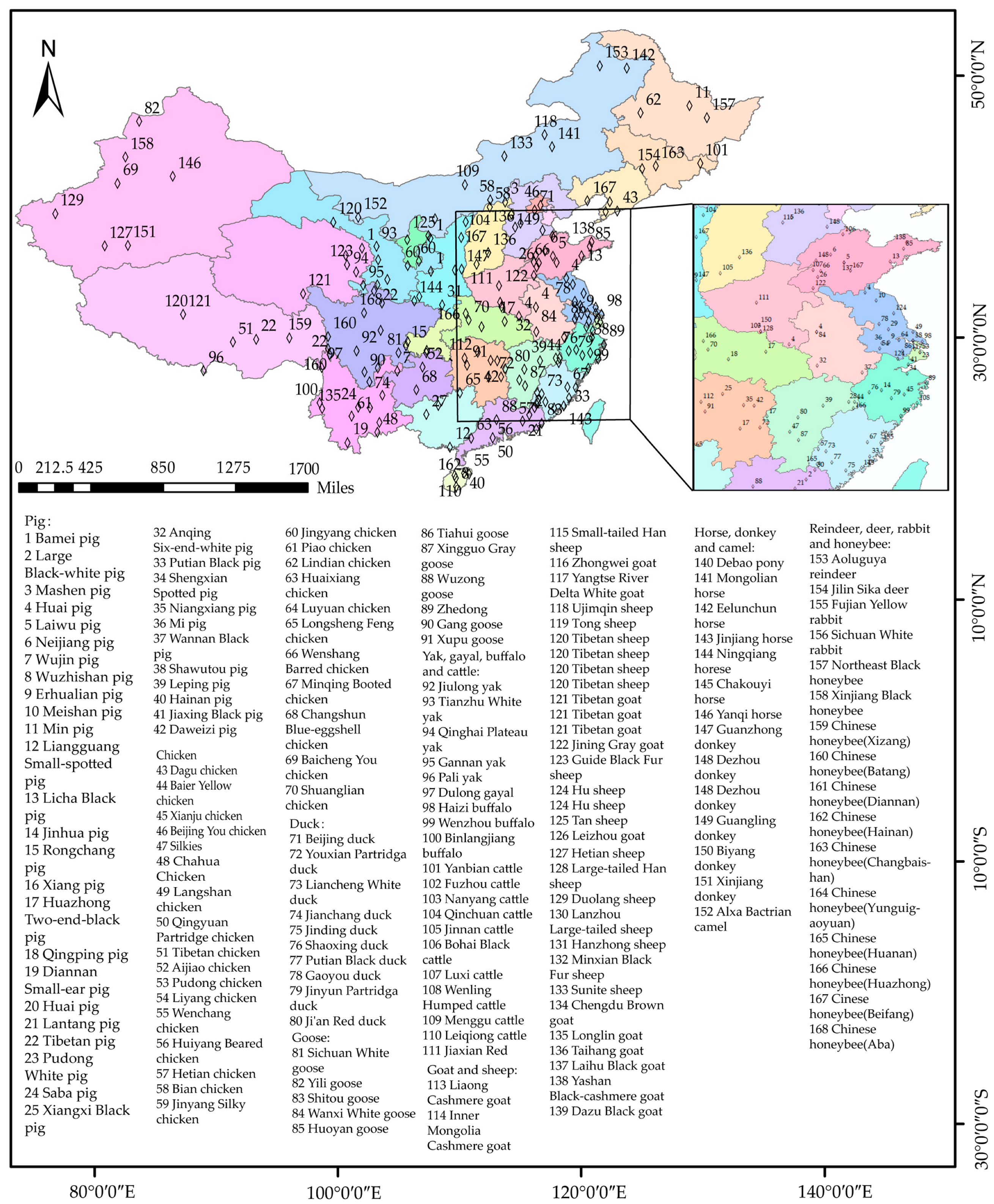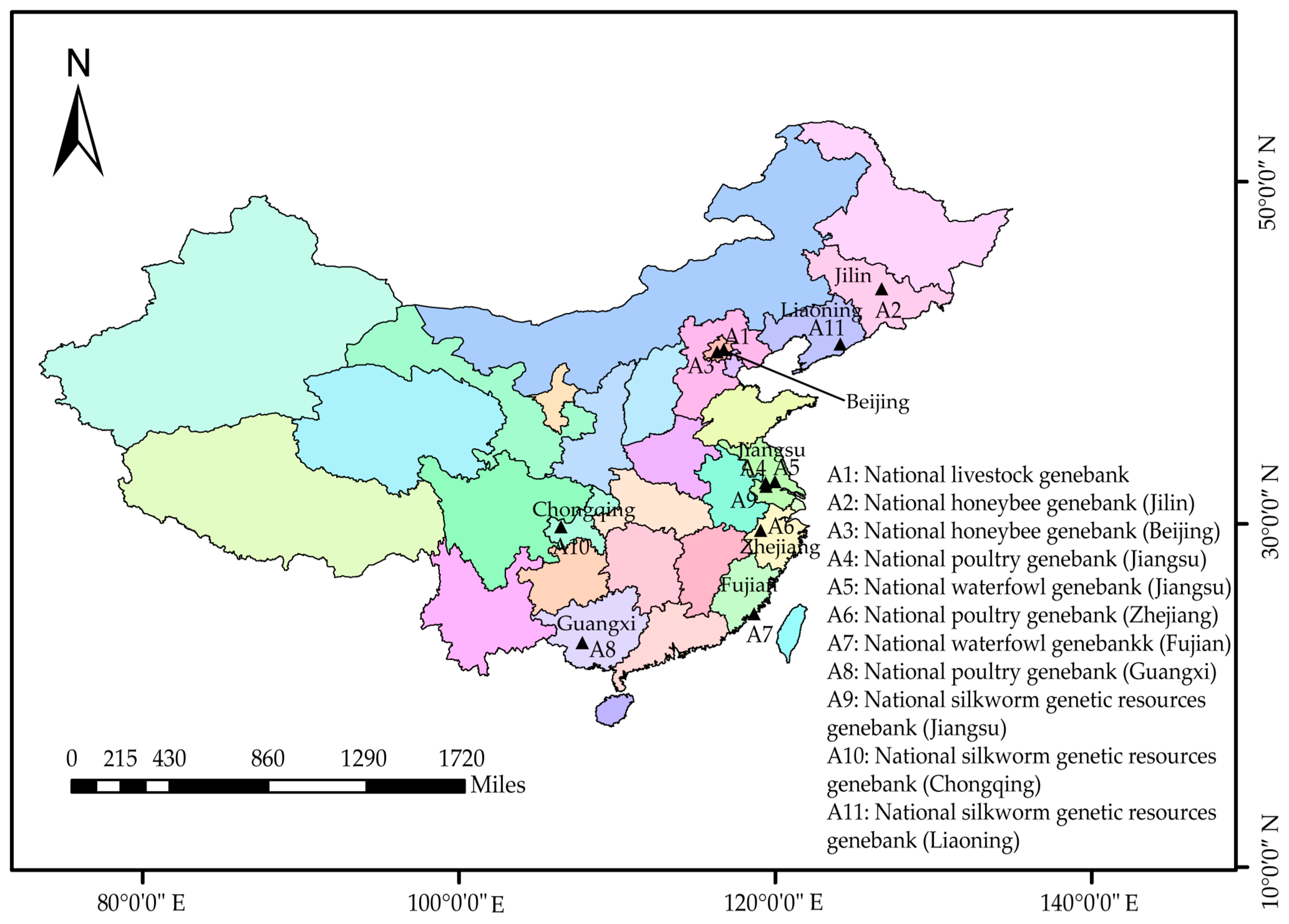Conservation of Domestic Animal Genetic Resources in China: Overview of the Status, Activities, Policies, and Challenges
Abstract
1. Introduction
2. Status of Domestic Animal Resources in China
3. Conservation Activities on Domestic Animals Resources in China
3.1. Implemented the National Investigations on Domestic Animal Resources
3.2. Formulating the National List of Protected Domestic Animals
3.3. Construction of the Protection System for Domestic Animal Resources in China
4. Sustainable Use and Development of Domestic Animal Resources in China
5. Conservation Policies in China
6. Challenges in Sustainable Use and Development of Domestic Animals in China
6.1. The Utilization of Local Breeds
6.2. The Genetic Mechanism of Excellent Traits
6.3. The Resource Disappearance Risk
6.4. The Biosafety Risks
7. Suggestions for Sustainable Use and Development of Domestic Animals
7.1. Establish Regular Investigations on Domestic Animal Resources
7.2. Develop Programs for the Conservation of Domestic Animals Resources
7.3. Clarify the Responsibility for Conservation of Domestic Animal Resources
7.4. Promote the Development and Utilization of Domestic Animal Genetic Resources
7.5. Cultivate Professionals for Sustainable Use and Develop of Domestic Animal Resources
7.6. Awareness of Domestic Animal Keepers for Maintaining Pure Germplasm
8. Conclusions
Author Contributions
Funding
Institutional Review Board Statement
Informed Consent Statement
Data Availability Statement
Conflicts of Interest
References
- Ligda, C.; Zjalic, M. Conservation of animal genetic resources in Europe: Overview of the policies, activities, funding and expected benefits of conservation activities. Anim. Genet. Resour. 2011, 49, 75–86. [Google Scholar] [CrossRef]
- Gáspárdy, A. Biotechnology assisted approaches in the preservation of rare breeds’ diversity. Danub. Anim. Genet. Resour. 2024, 2, 6. [Google Scholar] [CrossRef]
- IRB UN. Convention on Biological Diversity; Treaty Collection; IRN UN: New Delhi, India, 1992. [Google Scholar]
- Department of Seed Management, Ministry of Agriculture and Rural Affairs of the People’s Republic of China. Report on Domestic Animal Genetic Resources in China; China Agricultural University Press: Beijing, China, 2024. [Google Scholar]
- Zhou, R.; Li, S.; Yao, W.; Xie, C.; Kui, L. The Meishan pig genome reveals structural variation mediated gene expression and phenotypic divergence underlying Asian pig domestication. Mol. Ecol. Resour. 2021, 21, 2077–2092. [Google Scholar] [CrossRef] [PubMed]
- Ren, Q.; Gong, Y.; Su, P.; Liu, G.; Pu, Y.; Yu, F.; Ma, Y.; Wang, Z.; Li, Y.; Jiang, L. How Developments in Genebanks Could Shape Utilization Strategies for Domestic Animals. Agriculture 2025, 15, 133. [Google Scholar] [CrossRef]
- Wang, Y.; Zhu, B.; Wang, J.; Zhang, L.; Xu, L.; Chen, Y.; Wang, Z.; Gao, H.; Li, J.; Gao, X. Evaluation of genomic mating approach based on genetic algorithms for long-term selection in Huaxi cattle. BMC Genom. 2024, 25, 1140. [Google Scholar] [CrossRef]
- Farm Animal Genetic Resources Committee. Livestock and Poultry Genetic Resources in China; China Agricultural Press: Beijing, China, 2011. [Google Scholar]
- Yu, D.; Wang, L.; Hu, F. Agro-biodiversity conservation and implications in China. In Organic Agriculture and Biodiversity in China; Elsevier: Amsterdam, The Netherlands, 2024; pp. 25–45. [Google Scholar]
- Ovaska, U.; Bluer, A.; Krolkke, C.; Kjets, M.; Kantanen, J.; Honkatukia, M. The Conservation of Native Domestic Animal Breeds in Nordic Countries: From Genetic Resources to Cultural Heritage and Good Governance. Animals 2021, 11, 2730. [Google Scholar] [CrossRef]
- Ministry of Agriculture and Rural Affairs of the People’s Republic of China. 2021-453: National Level Livestock and Poultry Genetic Resource Gene Bank, Conservation Farms, and Protected Areas (First Batch). 2021. Available online: https://www.moa.gov.cn/nybgb/2021/202112/202112/t20211231_6386155.htm (accessed on 1 February 2023).
- Ministry of Agriculture and Rural Affairs of the People’s Republic of China. 2023-720: Announcement on the Publication of the List of National Livestock and Poultry Genetic Resources Protection Areas (Second Batch) and Other Matters. 2023. Available online: https://www.moa.gov.cn/govpublic/nybzzj1/202312/t20231207_6442237.htm (accessed on 1 February 2023).
- Ministry of Agriculture and Rural Affairs of the People’s Republic of China. 2023-631: National Livestock and Poultry Genetic Resources Conservation Farm and Gene Bank (Second Batch). 2023. Available online: https://www.moa.gov.cn/nybgb/2023/202301/202302/t20230214_6420459.htm (accessed on 1 February 2023).
- Zhang, X.; Cai, S.; Chen, L.; Yuan, R.; Nie, Y.; Ding, S.; Fang, Y.; Zhu, Q.; Chen, K.; Wei, H.; et al. Integrated miRNA–mRNA transcriptomic analysis reveals epigenetic-mediated embryonic muscle growth differences between Wuzhishan and Landrace pigs. J. Anim. Sci. 2019, 97, 1967–1978. [Google Scholar] [CrossRef]
- Yang, Y.; Sun, C.; Li, F.; Shan, A.; Shi, B. Characteristics of faecal bacterial flora and volatile fatty acids in Min pig, Landrace pig, and Yorkshire pig Characteristics of faecal bacterial flora and volatile fatty acids in Min pig, Landrace pig, and Yorkshire pig. Electron. J. Biotechnol. 2021, 53, 33–43. [Google Scholar] [CrossRef]
- Wu, X.; Pei, J.; Xiong, L.; Ge, Q.; Bao, P.; Liang, C.; Yan, P.; Guo, X. Genome-wide scan for selection signatures reveals novel insights into the adaptive capacity characteristics in three Chinese cattle breeds. BMC Genom. 2025, 26, 206. [Google Scholar] [CrossRef]
- Gao, X.; Wang, S.; Wang, Y.-F.; Li, S.; Wu, S.-X.; Yan, R.-G.; Zhang, Y.-W.; Wan, R.-D.; He, Z.; Song, R.-D.; et al. Long read genome assemblies complemented by single cell RNA-sequencing reveal genetic and cellular mechanisms underlying the adaptive evolution of yak. Nat. Commun. 2022, 13, 4887. [Google Scholar] [CrossRef]
- Kong, Y.; Wen, Z.; Cai, X.; Tan, L.; Liu, Z.; Wang, Q.; Li, Q.; Yang, N.; Wang, Y.; Zhao, Y. Genetic traceability, conservation effectiveness, and selection signatures analysis based on ancestral information: A case study of Beijing-You chicken. BMC Genom. 2025, 26, 402. [Google Scholar] [CrossRef] [PubMed]
- Zhou, R.; Yang, Y.; Liu, Y.; Chen, J.; Yang, B.; Tang, Z. High serum reproductive hormone levels at mid-pregnancy support Meishan pig prolificacy High serum reproductive hormone levels at mid-pregnancy support Meishan pig prolificacy. J. Integr. Agric. 2023, 22, 3489–3499. [Google Scholar] [CrossRef]
- Guan, D.; Bai, Z.; Zhu, X.; Zhong, C.; Hou, Y.; Zhu, D.; Li, H.; Lan, F.; Diao, S.; Yao, Y.; et al. Genetic regulation of gene expression across multiple tissues in chickens. Nat. Genet. 2025, 57, 1298–1308. [Google Scholar] [CrossRef]
- Huang, Y.; Zhou, L.; Zhang, J.; Liu, X.; Huang, L. A large-scale comparison of meat quality and intramuscular fatty acid composition among three Chinese indigenous pig breeds. Meat Sci. 2020, 168, 108182. [Google Scholar] [CrossRef]
- Sponenberg, D.P.; Martin, A.; Couch, C.; Beranger, J. Conservation Strategies for Local Breed Biodiversity. Diversity 2019, 11, 177. [Google Scholar] [CrossRef]
- Polak, G.; Krupiński, J.; Martyniuk, E.; Calik, J.; Kawęcka, A.; Krawczyk, J.; Majewska, A.; Sikora, J.; Sosin-Bzducha, E.; Szyndler-Nędza, M.; et al. The risk status of Polish local breeds under conservation programmes—New approach. Ann. Anim. Sci. 2021, 21, 125–140. [Google Scholar] [CrossRef]
- Mendelsohn, R. The challenge of conserving indigenous domesticated animals. Ecol. Econ. 2003, 45, 501–510. [Google Scholar] [CrossRef]
- Garner, B.A.; Hand, B.K.; Amish, S.J.; Bernatchez, L.; Foster, J.T.; Miller, K.M.; Morin, P.A.; Narum, S.R.; O’Brien, S.J.; Roffler, G. Genomics in Conservation: Case Studies and Bridging the Gap between Data and Application. Trends Ecol. Evol. 2016, 31, 81–83. [Google Scholar] [CrossRef] [PubMed]
- Hohenlohe, P.A.; Funk, W.C.; Rajora, O.P. Population genomics for wildlife conservation and management. Mol. Ecol. 2021, 30, 62–82. [Google Scholar] [CrossRef]
- Marx, V. Conservation genomics in practice. Nat. Methods 2022, 19, 522–525. [Google Scholar] [CrossRef]
- Wu, Y.; Huang, C.; Wei, Y.; Kang, Z.; Zhang, W.; Xie, J.; Xiong, L.; Zhou, M.; Zhang, G.; Chen, R. Comparative analysis of the growth differences between hybrid Ningdu Yellow chickens and their parentals. Poult. Sci. 2024, 103, 104239. [Google Scholar] [CrossRef] [PubMed]
- Chen, L.; Wang, X.; Cheng, D.; Chen, K.; Fan, Y.; Wu, G.; You, J.; Liu, S.; Mao, H.; Ren, J. Population genetic analyses of seven Chinese indigenous chicken breeds in a context of global breeds. Anim. Genet. 2019, 50, 82–86. [Google Scholar] [CrossRef] [PubMed]
- Zhao, Q.; Liu, H.; Qadri, Q.R.; Wang, Q.; Pan, Y.C.; Su, G. Long-term impact of conventional and optimal contribution conservation methods on genetic diversity and genetic gain in local pig breeds. Heredity 2021, 127, 546–553. [Google Scholar] [CrossRef]
- Peng, W.; Zhang, Y.; Gao, L.; Wang, S.; Liu, M.; Sun, E.; Lu, K.; Zhang, Y.; Li, B.; Li, G. Examination of homozygosity runs and selection signatures in native goat breeds of Henan, China. BMC Genom. 2024, 25, 1184. [Google Scholar] [CrossRef]
- Fan, H.Z.; Hu, Y.B.; Wu, Q.; Nie, Y.G.; Yan, L.; Wei, F.W. Conservation genetics and genomics of threatened vertebrates in China. J. Genet. Genom. 2018, 45, 593–601. [Google Scholar] [CrossRef]
- Formenti, G.; Theissinger, K.; Fernandes, C.; Bista, I.; Bombarely, A.; Bleidorn, C.; Ciofi, C.; Crottini, A.; Godoy, J.A.; Höglund, J.; et al. The era of reference genomes in conservation genomics. Trends Ecol. Evol. 2022, 37, 197–202. [Google Scholar] [CrossRef]
- Zhou, X.; Guang, X.; Sun, D.; Xu, S.; Li, M.; Seim, I.; Jie, W.; Yang, L.; Zhu, Q.; Xu, J.; et al. Population genomics of finless porpoises reveal an incipient cetacean species adapted to freshwater. Nat. Commun. 2018, 9, 1276. [Google Scholar] [CrossRef]
- Zhou, X.; Meng, X.; Liu, Z.; Chang, J.; Wang, B.; Li, M.; Wengel, P.O.-t.; Tian, S.; Wen, C.; Wang, Z.; et al. Population Genomics Reveals Low Genetic Diversity and Adaptation to Hypoxia in Snub-Nosed Monkeys. Mol. Biol. Evol. 2016, 33, 2670–2681. [Google Scholar] [CrossRef]
- Wang, T.; Cai, Z.; Bai, X.; Zhong, H.; Li, D.; Chen, B. Population genomics and transcriptomics identify patterns of selection in two Liangshan chicken breeds. Br. Poult. Sci. 2025, 66, 458–467. [Google Scholar] [CrossRef]
- Wang, J.; Liu, J.; Lei, Q.; Liu, Z.; Han, H.; Zhang, S.; Qi, C.; Liu, W.; Li, D.; Li, F. Elucidation of the genetic determination of body weight and size in Chinese local chicken breeds by large-scale genomic analyses. BMC Genom. 2024, 25, 15. [Google Scholar] [CrossRef] [PubMed]
- Quan, J.; Gao, C.; Cai, Y.; Ge, Q.; Zhao, S. Population genetics assessment model reveals priority protection of genetic resources in native pig breeds in China. Glob. Ecol. Conserv. 2019, 21, e00829. [Google Scholar] [CrossRef]
- Hilimire, K. Integrated Crop/Livestock Agriculture in the United States: A Review. J. Sustain. Agric. 2011, 35, 376–393. [Google Scholar] [CrossRef]
- He, J.; Wu, X.L.; Zeng, Q.; Li, H.; Bauck, S. Genomic mating as sustainable breeding for Chinese indigenous Ningxiang pigs. PLoS ONE 2020, 15, e0236629. [Google Scholar] [CrossRef]
- FAO. Status and Trends of Animal Genetic Resources-2022. 2023. Available online: https://www.fao.org/home/zh (accessed on 18 February 2023).
- Orelle, A.; Nikiema, A.; Zakaryan, A.; Albetkova, A.A.; Rayfield, M.A.; Peruski, L.F.; Pierson, A.; Kachuwaire, O. National Biosafety Management System: A Combined Framework Approach Based on 15 Key Elements. Front. Public Health 2021, 9, 609107. [Google Scholar] [CrossRef]
- Ma, M.; Wang, H.H.; Hua, Y.; Qin, F.; Yang, J. African swine fever in China: Impacts, responses, and policy implications. Food Policy 2021, 102, 102065. [Google Scholar] [CrossRef]
- Shirey, V.M.; Lewthwaite, J.M.M.; Gawel, A.M.; Guzman, L.M. 50 years of invertebrate conservation under the United States Endangered Species Act—History and threats to species. Front. Conserv. Sci. 2025, 6, 1505451. [Google Scholar] [CrossRef]
- Du, H.; Zhou, L.; Liu, Z.; Zhuo, Y.; Zhang, M.; Huang, Q.; Lu, S.; Xing, K.; Jiang, L.; Liu, J.F. The 1000 Chinese Indigenous Pig Genomes Project provides insights into the genomic architecture of pigs. Nat. Commun. 2024, 15, 10137. [Google Scholar] [CrossRef]
- Chebo, C.; Betsha, S.; Melesse, A. Chicken genetic diversity, improvement strategies and impacts on egg productivity in Ethiopia: A review. World’s Poult. Sci. J. 2022, 78, 803–821. [Google Scholar] [CrossRef]
- Qiu, Y.; Liu, L.; Huang, M.; Ruan, D.; Ding, R.; Zhang, Z.; Zheng, E.; Wang, S.; Deng, S.; Meng, X.; et al. Origins, Dispersal, and Impact: Bidirectional Introgression Between Chinese and European Pig Populations. Adv. Sci. 2025, 12, e2416573. [Google Scholar] [CrossRef]
- Ugarte, E.; Ruiz, R.; Gabiña, D.; Beltrán de Heredia, I. Impact of high-yielding foreign breeds on the Spanish dairy sheep industry. Livest. Prod. Sci. 2001, 71, 3–10. [Google Scholar] [CrossRef]
- Zhang, D.; Cheng, J.; Li, X.; Huang, K.; Yuan, L.; Zhao, Y.; Xu, D.; Zhang, Y.; Zhao, L.; Yang, X.; et al. Comprehensive multi-tissue epigenome atlas in sheep: A resource for complex traits, domestication, and breeding. iMeta 2024, 3, e254. [Google Scholar] [CrossRef] [PubMed]
- Li, X.; Lan, F.; Chen, X.; Yan, Y.; Li, G.; Wu, G.; Sun, C.; Yang, N. Runs of homozygosity and selection signature analyses reveal putative genomic regions for artificial selection in layer breeding. BMC Genom. 2024, 25, 638. [Google Scholar] [CrossRef] [PubMed]
- Wollny, C.B.A. The need to conserve farm animal genetic resources in Africa: Should policy makers be concerned? Ecol. Econ. 2003, 45, 341–351. [Google Scholar] [CrossRef]
- Quan, J.; Yang, M.; Wang, X.; Cai, G.; Ding, R.; Zhuang, Z.; Zhou, S.; Tan, S.; Ruan, D.; Wu, J.; et al. Multi-omic characterization of allele-specific regulatory variation in hybrid pigs. Nat. Commun. 2024, 15, 5587. [Google Scholar] [CrossRef]
- Adekale, D.; Liu, Z.; Evans, R.; Pabiou, T.; Reents, R.; Segelke, D.; Tetens, J. The impact of deregressed foreign breeding values on national beef cattle single-step genomic evaluation. Genet. Sel. Evol. 2025, 57, 37. [Google Scholar] [CrossRef]





| Classification | Species | Local Breed | Cultivated Breed | Crossbred | Introduced Breed | Introduced Crossbred | Total |
|---|---|---|---|---|---|---|---|
| Traditional domestic animals | Pig | 89 | 32 | 18 | 6 | 2 | 147 |
| Cattle | 58 | 11 | 0 | 15 | 0 | 84 | |
| Zebu | 0 | 0 | 0 | 1 | 0 | 1 | |
| Buffalo | 27 | 0 | 0 | 3 | 0 | 30 | |
| Yak | 24 | 2 | 0 | 0 | 0 | 26 | |
| Gayal | 1 | 0 | 0 | 0 | 0 | 1 | |
| Sheep | 58 | 38 | 0 | 14 | 0 | 110 | |
| Goat | 69 | 15 | 0 | 6 | 0 | 90 | |
| Horse | 29 | 14 | 0 | 17 | 0 | 60 | |
| Donkey | 24 | 0 | 0 | 0 | 0 | 24 | |
| Camel | 5 | 0 | 0 | 0 | 0 | 5 | |
| Rabbit | 8 | 13 | 5 | 10 | 4 | 40 | |
| Chicken | 140 | 5 | 104 | 8 | 32 | 289 | |
| Duck | 42 | 0 | 16 | 1 | 7 | 66 | |
| Goose | 32 | 1 | 4 | 0 | 6 | 43 | |
| Pigeon | 6 | 0 | 3 | 3 | 1 | 13 | |
| Quail | 0 | 0 | 1 | 2 | 0 | 3 | |
| Special domestic animals | Sika deer | 1 | 7 | 0 | 0 | 0 | 8 |
| Red deer | 3 | 3 | 0 | 1 | 0 | 7 | |
| Reindeer | 1 | 0 | 0 | 0 | 0 | 1 | |
| Alpaca | 0 | 0 | 0 | 1 | 0 | 1 | |
| Turkey | 1 | 0 | 0 | 2 | 2 | 5 | |
| Guinea fowl | 0 | 0 | 0 | 1 | 0 | 1 | |
| Pheasant | 2 | 2 | 0 | 1 | 0 | 5 | |
| Partridge | 0 | 0 | 0 | 1 | 0 | 1 | |
| Muscovy duck | 1 | 0 | 2 | 1 | 1 | 5 | |
| Mallard | 0 | 0 | 0 | 1 | 0 | 1 | |
| Ostrich | 0 | 0 | 0 | 3 | 0 | 3 | |
| Emu | 0 | 0 | 0 | 1 | 0 | 1 | |
| Mink (non-food animal) | 0 | 8 | 0 | 5 | 0 | 13 | |
| Silver fox (non-food animal) | 0 | 0 | 0 | 2 | 0 | 2 | |
| Arctic fox (non-food animal) | 0 | 0 | 0 | 1 | 0 | 1 | |
| Racoon dog (non-food animal) | 1 | 2 | 0 | 0 | 0 | 3 | |
| Total | 622 | 153 | 153 | 107 | 55 | 1090 |
Disclaimer/Publisher’s Note: The statements, opinions and data contained in all publications are solely those of the individual author(s) and contributor(s) and not of MDPI and/or the editor(s). MDPI and/or the editor(s) disclaim responsibility for any injury to people or property resulting from any ideas, methods, instructions or products referred to in the content. |
© 2025 by the authors. Licensee MDPI, Basel, Switzerland. This article is an open access article distributed under the terms and conditions of the Creative Commons Attribution (CC BY) license (https://creativecommons.org/licenses/by/4.0/).
Share and Cite
Chen, X.; Lu, J.; Cheng, W.; Xue, M.; Yu, F. Conservation of Domestic Animal Genetic Resources in China: Overview of the Status, Activities, Policies, and Challenges. Life 2025, 15, 1420. https://doi.org/10.3390/life15091420
Chen X, Lu J, Cheng W, Xue M, Yu F. Conservation of Domestic Animal Genetic Resources in China: Overview of the Status, Activities, Policies, and Challenges. Life. 2025; 15(9):1420. https://doi.org/10.3390/life15091420
Chicago/Turabian StyleChen, Xiao, Jian Lu, Wenqiang Cheng, Ming Xue, and Fuqing Yu. 2025. "Conservation of Domestic Animal Genetic Resources in China: Overview of the Status, Activities, Policies, and Challenges" Life 15, no. 9: 1420. https://doi.org/10.3390/life15091420
APA StyleChen, X., Lu, J., Cheng, W., Xue, M., & Yu, F. (2025). Conservation of Domestic Animal Genetic Resources in China: Overview of the Status, Activities, Policies, and Challenges. Life, 15(9), 1420. https://doi.org/10.3390/life15091420







